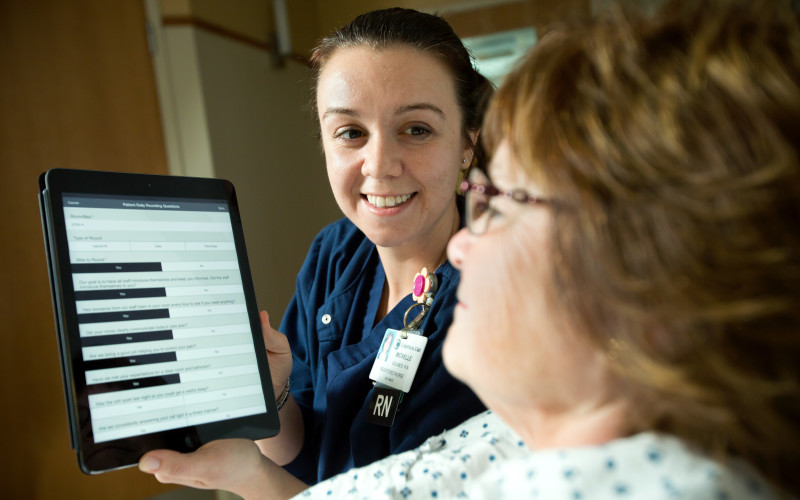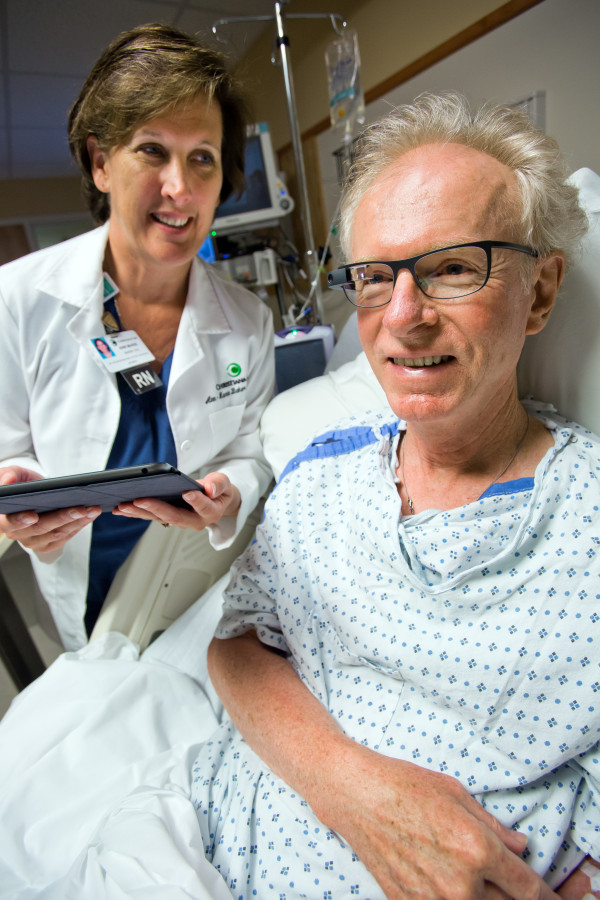Nurses leverage iRound technology to address patient needs faster

As Christiana Care Health System deploys new iRound technology on mobile devices, nurse leaders are reporting more purposeful interactions with patients during daily rounds, and these interactions are leading to care that is more responsive to patient needs.
In 2014, the Department of Nursing partnered with the Office of Patient Experience to introduce “iRound for Patient Experience” on 31 inpatient units. This year the program will likely expand to the Emergency Department and other units.
“Equipping our nurse leaders with this easy-to-use technology is the perfect way to balance purposeful rounding while building relationships with patients and families,” said Shawn R. Smith, MBA, vice president, Patient Experience. “Collecting real-time data and responding immediately to patient needs is really patient experience 2.0. In the last seven months we have logged over 50,000 rounds.”
“We’re really there to make improvements, and that builds trust. The patient feedback has been overwhelmingly positive.”
As nurses round on patients, they record the answers to a structured set of questions on the application, which runs on iPads. If a problem is identified, the iRound sessions give nurses a chance to immediately respond to the patient with empathy, apologize for what has occurred and work with staff to set the matter right.
“With the iRound, we have a data-collection device that allows us to react in the moment to improve patient care,” said Pamela Boyd, MSN, RN, CNOR, senior program manager, Patient Experience.
For example, if a nurse discovers a physical problem in the patient’s room, she can take a picture with the iPad and send it to the appropriate hospital department, giving the repair team a clear sense of what they are called on to do. The goal is to address the issue quickly and communicate to the patient that it is being corrected, preferably before discharge, Boyd said.
“This is more than ‘Hi, how are you and is everything OK?’” said Dennis Harris, MSN, RN-BC, nurse manager of 6A. “We’ve standardized the process of asking about the experience our patients are having. But it’s the human touch of entering into a conversation where we show our concern that makes all the difference.”
During an iRound patient experience, nurses are taught to introduce themselves and make eye contact, ask for a few minutes of the patient’s time, and sit with the patient and family members, if present. The interaction often begins with a demonstration of how the iPad is being used, so that the technology becomes a natural part of the conversation and not a distraction.

Nurses then cover a standard list of questions. Do staff introduce themselves when they enter the room? Is it quiet enough to sleep? Are nurses explaining medications? Are there any cleanliness issues? Is the nurse effectively communicating your plan for the day?
“Conversations can take two minutes or 20 minutes, depending on what patients or families want to share,” said Pam Owen, BSN, RN-BC, assistant nurse manager on 7E. “We’ve been taught to listen with empathy and let patients know we want their experience to be the best that it can be. We’re really there to make improvements, and that builds trust. The patient feedback has been overwhelmingly positive.”
Often, nurses learn of caring interactions between patients and staff while rounding with iRound. These compliments can be shared with the entire care team.
“It tells staff this is a tool for reinforcing the great work they do,” Harris said. He said the process gives nurses a sense of satisfaction because it helps them to feel more connected to their patients.
The new rounding process is expected to improve scores on the Hospital Consumer Assessment of Healthcare Providers and Systems (HCAHPS), a national survey of patient hospital experience, said Boyd. The Centers for Medicare & Medicaid Services (CMS) have made it clear that government reimbursements will be increasingly tied to scores that patients report after a hospital experience. CMS also posts scores on Medicare’s Hospital Compare website.
“We expect consumers to compare scores and seek out hospitals offering the best patient experience,” said Boyd.
But iRound technology is new and needs to be properly introduced to patients and staff. “So we have to ask, how do we interact and collect data from patients so that it is part of our workflow and not obstructive,” said Janine Jordan, M.D., medical director of Care Transition and Utilization Management.
There is also the question of the optimal training for learning iRound. Christiana Care is conducting research on this issue through the Value Institute, Dr. Jordan said. One aspect of the research looks at the effects of an innovative nurse training carried out by the Virtual Education and Simulation Training Center in November. The team created videos showing nurse leaders giving three types of the iRound experience — poor, mediocre and excellent. The videos were made with standardized patients — individuals who are trained to act as hospital patients in simulation training. They wore Google Glass, the wearable computer and video device with a head-mounted display, to record patient’s-eye-view videos of the varying experiences.
“It was exciting to bring that kind of technology into a training event like this,” said Michael Azzolina, simulation technology specialist for the Virtual Education and Simulation Training Center, who provided technical support in the use of Google Glass for the project. “I think it helped to give the learners a different perspective. It allowed them to see themselves from the patient’s point of view, which I think can be a very valuable tool in training someone how to interact with the public. We’re always looking for ways to leverage technology like Google Glass to make education more engaging and more effective.”
After watching the videos as part of their training, nurses had a chance to practice iRounding with standardized patients and heard immediate feedback on what went well and where they could improve.
“As clinicians, we seldom try something new and have the opportunity to hear immediate feedback from a patient’s perspective,” said Ann-Marie C. Baker, MSN, RN-BC, senior program manager, Patient Experience. “The simulation practice really provided an opportunity to learn how our manner made another person feel.”
Because the standardized patients were trained to pick up on the subtle differences that separate a good experience from a great experience, they were able to provide candid, useful feedback that enabled the nurses to quickly develop skill and comfort with the process.
“The unique design of this project allowed us to combine cutting-edge technology and simulation to train for an optimal interaction with patients,” said Susan Coffey Zern, M.D., CHSE, director, Virtual Education and Simulation TrainingCenter. “We have the ability to modify this project for other departments to practice and truly master skills that will impact the care of our patients.”
As a follow-up to the initial training, Boyd and other educators are visiting patient care units throughout Christiana Care to talk about how staff are adapting to the technology. “We are staying in touch and giving our nurses training boosters so they will feel equipped to purposefully interact,” said Boyd. “How we listen to patient concerns will determine our success.”